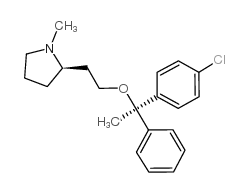Clemastine
Modify Date: 2025-08-20 17:39:07

Clemastine structure
|
Common Name | Clemastine | ||
|---|---|---|---|---|
| CAS Number | 15686-51-8 | Molecular Weight | 343.89000 | |
| Density | 1.097 g/cm3 | Boiling Point | 425.2ºC at 760mmHg | |
| Molecular Formula | C21H26ClNO | Melting Point | N/A | |
| MSDS | N/A | Flash Point | 211ºC | |
Use of ClemastineClemastine (HS-592) is a potent and orally active histamine receptor H1 antagonist. Clemastine is an antihistamine mainly used for relieving symptoms of allergic reactions primarily by competing with histamine to bind H1 receptors. Anti-inflammatory effects[1][2]. |
| Name | clemastine |
|---|---|
| Synonym | More Synonyms |
| Description | Clemastine (HS-592) is a potent and orally active histamine receptor H1 antagonist. Clemastine is an antihistamine mainly used for relieving symptoms of allergic reactions primarily by competing with histamine to bind H1 receptors. Anti-inflammatory effects[1][2]. |
|---|---|
| Related Catalog | |
| References |
| Density | 1.097 g/cm3 |
|---|---|
| Boiling Point | 425.2ºC at 760mmHg |
| Molecular Formula | C21H26ClNO |
| Molecular Weight | 343.89000 |
| Flash Point | 211ºC |
| Exact Mass | 343.17000 |
| PSA | 12.47000 |
| LogP | 5.04230 |
| Index of Refraction | 1.553 |
| MFCD00137486 |
| clemastinum |
| EINECS 239-055-2 |
| clemastine |